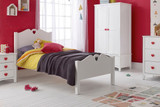How to make your childs bedroom a haven for sleep

Creating a haven for sleep is vital for your child’s well-being. A good night’s sleep helps your child to concentrate during the day, perform better academically and behave better. It also reduces stress and anxiety levels.
There are a few key things you can do to make your child’s bedroom a haven for sleep:
1) Eliminate distractions – remove televisions, computers, phones and any other electronic devices from the bedroom. These devices emit blue light which can interfere with sleep.
2) Keep the bedroom dark at night– invest in blackout curtains or blinds to block out external light sources. If your child is afraid of the dark, leave a small nightlight on in the room.
3) Make sure the bedroom is quiet – consider using a white noise machine to help drown out any external noise sources. If your child is sensitive to sound, earplugs may also be helpful.
4) Keep the bedroom cool – research has shown that cooler bedrooms (between 16-19 degrees Celcius) promote better sleep. Use fans or air conditioning units to achieve this temperature range.
5) Use comfortable bedding – make sure your child has a comfortable mattress and pillows that support their head and neck. Use breathable bedding materials such as cotton to help regulate body temperature during sleep.
The Bed
A bed is more than just a piece of furniture; it’s a special place where your child can relax and feel safe. Here are some tips to make sure your child’s bed is a comfortable and restful retreat:
-Choose the right size bed. A twin-size bed is ideal for most children under 12, while a full-size bed may be more comfortable for older children or teens.
-Invest in some nice sheets. High-quality sheets made from natural fibers like cotton or linen are worth the investment; not only will they look and feel better, but they’ll also last longer than cheaper synthetic options.
The Pillow
There are many types of pillow on the market, but what is the best type of pillow for your child?
down pillow, or one made of memory foam?
Down pillows are usually more expensive than those made of Memory foam, but they offer superior comfort and support. Down pillows are also less likely to cause allergies.
Memory foam pillows are made from a viscoelastic material that contours to the shape of your head and neck. These pillows provide good support and can help to prevent pain in the neck and shoulders.
The Mattress
Your child’s mattress is one of the most important pieces of furniture in their bedroom. It should be comfortable and support your child’s back, neck and head. A good mattress will last about 10 years, so it’s important to choose wisely.
There are a few things to keep in mind when shopping for a mattress:
-Firmness: A mattress should be firm enough to support your child’s body, but not so firm that it’s uncomfortable. You should be able to press down on the mattress and feel some give.
-Size: Make sure to measure your child’s bed frame before you buy a mattress. You don’t want to end up with a mattress that’s too big or too small for the bed.
The Bedroom Light
There are a few things to consider when thinking about the best lighting for your bedroom. First, you’ll want to think about the level of light you need. Do you need a bright light for reading or working in your bedroom? Or do you prefer a softer light for relaxing in bed?
Next, you’ll want to think about the type of light you need. There are a few different options:
- Incandescent bulbs emit a warm, soft light and are good for relaxing in bed.
- Compact fluorescent bulbs (CFLs) emit a bright, white light and are good for reading or working in your bedroom.
- LEDs emit a bright, white light and use less energy than incandescent or CFL bulbs.
Finally, you’ll want to consider the size and shape of your bedroom when choosing lighting fixtures. If your bedroom is small, you’ll want to choose smaller lamps or overhead lights instead of large chandeliers or floor lamps.
Creating a Bedtime Routine
Creating a bedtime routine is important for helping your child wind down at the end of the day and prepare for sleep. A bedtime routine should be calming and not include any stimulating activities such as watching television or playing video games. A typical bedtime routine might include the following activities:
-Taking a bath
-Brushing teeth
-Putting on pajamas
-Reading a story
It is also important to establish a consistent bedtime and stick to it as much as possible. This will help train your child’s body to know when it is time to sleep.
Conclusion
In conclusion, there are many things you can do to make your child’s bedroom a haven for sleep. By following the tips above, you can create a space that is both comfortable and inviting, and that will help your child to get the restful sleep they need.
Recent Posts
-
Our Top 5 White Single Beds for Kids
One of the most popular types of childrens single bed is a classic white single bed. Offerin
-
Why Magical Mid Sleeper Beds are a Kid's Dream
When it comes to creating a bedroom for your child, you want it to be a place that inspires their im







